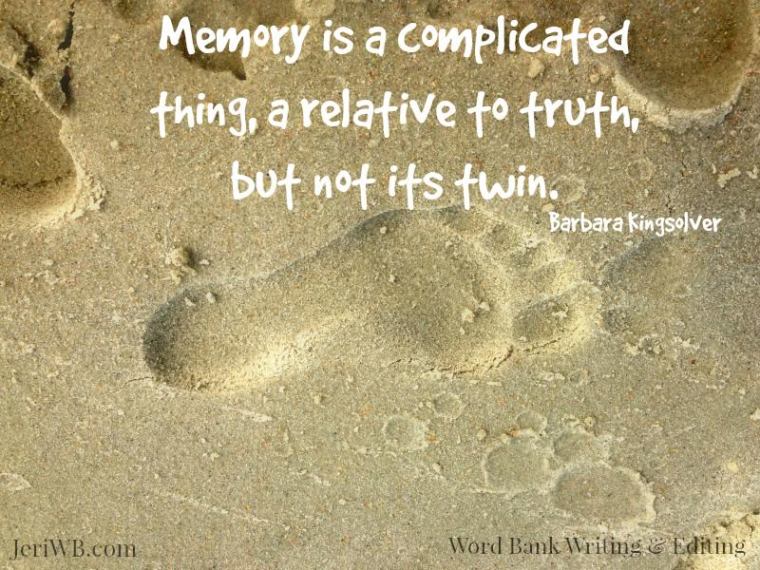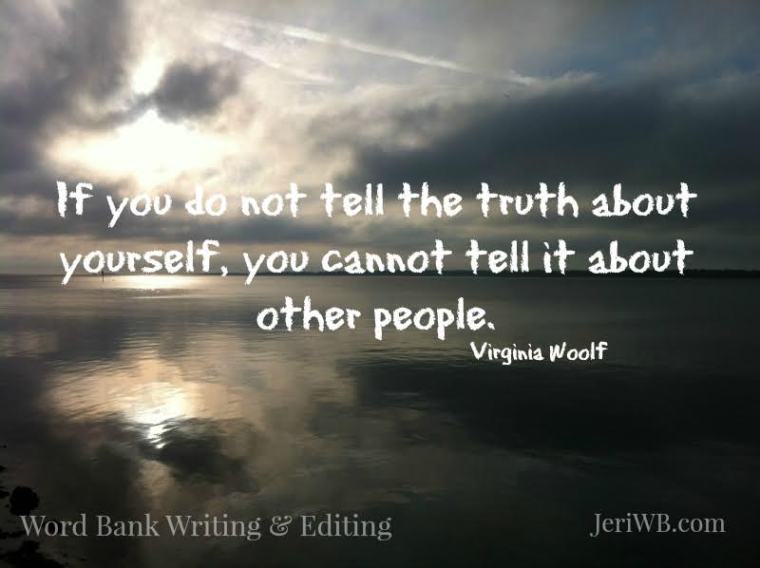Today, I’m excited to introduce on my blog, author/editor Jeri Walker. For those of you who may not be familiar with Jeri, she runs a popular blog, JeriWB – Word Bank and Editing – Make Every Word Count.
Jeri shares helpful articles about creative writing and great editing tips, does book reviews, and hosts author interviews on her blog. And today she has generously offered to make a guest appearance and talk about Creative Nonfiction writing.
Today, Jeri is posting here on the topic: Truth in Creative Nonfiction: What factors should writers consider when crafting reality?
Rendering the truth in creative nonfiction is an art form. Crafting a narrative involves shaping material to tell a real life story using the same literary techniques as fiction, but the story must be factually accurate. Whereas fiction begins in the imagination, creative nonfiction springs from actual events. Any writer who wants to coax a story from life’s seeming chaos has many choices to make.

Changing Memories
Memory is a fickle thing. People often don’t remember things accurately, and time can further erode or shift memories as newer influences come into play. A detail might be remembered inaccurately, but it’s still true to the writer’s memory. This raises the question of whether realizations of erroneous recollections should be alluded to as an equally important part of the narrative. The role of truth in creative nonfiction is also further complicated by how no two people will recall an event the same way.
Telling Truths Subjectively
Everyone experiences reality differently due to the subjective lenses they encounter the world with. A person’s unique backgrounds and beliefs act as a filter used to process events, and lifetimes are spent building frames of reference. Even the words chosen to describe an event shape its perception by an audience. The rendering of subject matter varies depending on the discourse community it’s intended for. It’s necessary to consider the goals and purposes of the particular group the text must reach.

Using Composite Characters
Bringing together the main traits and influence of two or more people into one composite character might be done to protect the so-called innocent or for the sake of supposedly streamlining the number of people in narrative, but doing so brings into question the ethics of doing so. Conflating characters might be done with the intention of strengthening the story, but as it shifts the focus into the imaginary realm.
[bctt tweet=”Once a writer feels compelled to add details that were not part of the story, the motivation for doing so must be questioned.” username=”pokercubster”]
Adding or Subtracting Details
Once a writer feels compelled to add details that were not part of the story, the motivation for doing so must be questioned. If the intent is to use imagined details to arrive at a greater truth, why not just write fiction since it can also communicate larger truths about the world? On the other hand, is it any more acceptable to simply not mention something by leaving it out entirely? Another tendency may be to compress time to speed up the story.

Disclosing Deception
The key is to always remember that truth in creative nonfiction entails being factually accurate. To do the genre justice, the writer must strive to provide an authentic representation of their reality to the best of their ability.
In any case, a nonfiction writer who does employ composite characters or other means of artistically shaping the truth, needs to provide a disclaimer. At the end of the day, has a writer really owned their story and rumbled with it if they have to fictionalize any of it?
What are your thoughts on truth in creative nonfiction?
About Jeri
Truth really is stranger than fiction, and it’s a long damn story. Jeri Walker’s short stories, creative nonfiction, and psychological novels (in progress) show the influence of being raised by a bipolar mother in the eccentric North Idaho mining town of Wallace as well as the trauma of being abandoned by her Jekyll-and-Hyde ex-husband whom she fell in love with while working in Yellowstone National Park.
She and her demanding pets call the Pacific Northwest home. In the continual pursuit of finding herself, Jeri plans to someday live in an RV or a tiny house. She dwells online at Word Bank Writing & Editing, grateful to be charting a course as a freelancer. Connect with her at JeriWB.com or browse her books.
You can check out Jeri’s services Editing Services Here, and her Freelance Writing Services Here
A brief biography of Jeri Walker of JeriWB Word Bank Writing and Editing Services.
Jeri Walker offers freelance writing services and editing services of incomparable quality at affordable rates. Her blog Make Every Word Count features weekly tips on writing, editing, publishing, marketing, and more. She is currently working on a book club discussion guide for authors that will be available to subscribers in early 2017.
Before transitioning to full-time freelancing, she worked on the editorial staff of The Idaho Review, . . .Continue Reading
Source: About Jeri Walker (@JeriWB)


